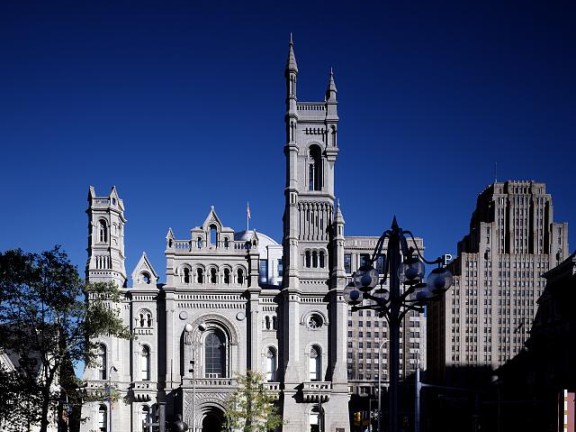Philadelphia Masonic Temple

The Masonic Temple at One North Broad Street in Philadelphia was constructed between 1868-73 by the Grand Lodge of Pennsylvania, Free and Accepted Masons. The oldest and largest fraternity in the world, Freemasonry’s origins can be traced to the Middle Ages, when stonemasons’ guilds and cathedral builders traveled throughout Europe. In 1717, four lodges in London formed the Grand Lodge of England, the first Grand Lodge in the world.
In the late 1700s, Freemasonry was one of the organizations most responsible for spreading the ideals of the Enlightenment in America: religious tolerance, merit and aspiration over birthright, personal civility, self-governance, and self-improvement through education.
The first Masonic lodge in America formed in Philadelphia, meeting in the Tun Tavern. Nine signers of the Declaration of Independence were Masons, including George Washington and Benjamin Franklin, who served as Grand Master of Pennsylvania Masons in 1734 and 1749. During the 1800s and early 1900s, Freemasonry grew dramatically.
After the American Revolution, Pennsylvania Masons continued to be leading supporters of philanthropic and educational work. With several lodges meeting in taverns and repurposed buildings, the first dedicated Masonic meeting space in the Western Hemisphere was Freemason’s Lodge in Philadelphia, which opened in 1755. By 1867, as the fraternity continued to grow, the Grand Lodge of Pennsylvania conducted a competition for a site on the northeast corner of Center Square. The project was led by Grand Master Richard Vaux (1816 –1895), who was elected mayor of Philadelphia in 1856.
The competition was won by the young James Windrim (1840-1919), who later served as the municipal architect and was responsible for many important civic and commercial buildings. He was chosen over James McArthur and Frank Furness, who would be the architects of the nearby City Hall and Pennsylvania Academy of the Fine Arts, respectively.
The Masonic Temple’s monumental Norman Revival style was popular at the time, as seen in the Tenth Presbyterian Church (built 1855-57) and Church of the Holy Trinity (1856-59), both in the then-developing residential section west of Broad Street. The Temple was built of brick-backed granite, rising three stories (plus an attic) from a rectangular basement and complemented by two asymmetrical towers, of which the taller, on the southwest corner, is 232 feet high.
The decoration of the interior is largely the work of the German-born and trained George Herzog (1851-1920), who came to America in 1873. Herzog also provided furnishings for City Hall and the houses of some of Philadelphia’s wealthiest citizens, including Peter A.B. Widener and Albert Disston. Much of his painting and lavish furnishing at the Masonic Temple was completed after the building opened in a great Masonic dedication ceremony on September 26, 1873.
Especially notable are the seven differently themed meeting rooms, in which the Grand Lodge and other Pennsylvania lodges and Masonic groups convene. “Oriental” Hall (1896), with Moorish motifs taken from the Alhambra, is on the ground floor, while the second floor has meeting rooms that are identified as Ionic (1890), Egyptian (1889), Norman (1891), Corinthian (1903), and Renaissance (1906). Gothic Hall (1908), on the third floor, is reserved for the Commandery, a Masonic order that took its name from the crusader fraternity of the Middle Ages and the Scottish Rite, a Masonic organization that offers a deeper exploration of Masonic teachings through a series of 29 degrees (the 4th through 32nd), which are presented as elaborate plays or ceremonies.
NHL nomination 1984